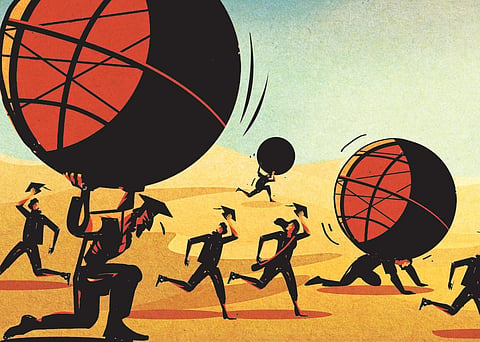

For many years, we have been waxing eloquent about India’s future demographic dividend that will soon lift us to the ranks of developed nations. A country enjoys the demographic dividend when the ratio of the working-age population to that of children and the elderly is high. Experts say India entered the demographic dividend window in 2005-06, and this opportunity will remain open till 2055-56. The ratio of the working-age population will be the highest between 2021 and 2041, peaking in the early 2030s.
In other words, we are already in the golden period, and if we can harness our nearly one billion working-age population, we can change the destiny of our country and the world. This, however, doesn't mean we will automatically achieve prosperity because we have a billion young people. Some prerequisites of utilising this potential are the availability of a healthy population, education, gender equality and bringing more women participation in gainful employment, a skilled workforce and high-quality employment generation.
The rise of the US, Japan and China after World War II were fuelled by the combination of all these factors. They were equipped to reap the dividend when it occurred. How prepared are we? The sad answer is that we have not readied our young population with these advantages.
From 2001 to 2011, we added one crore people to enter the labour force every year. Hardly a few lakhs had the qualifications and skill sets, and a few thousand got gainful employment every year. The National Family Health Survey (NFHS)-5 showed how grim the ground reality is and what the future holds for us if we don't get our act right and fast enough.
Dr K Srinath Reddy's opinion piece | Delivering comprehensive primary healthcare
Sometimes, one wonders what we achieved in 75 years of independence. What were the successive governments doing from 1947? As we await NFHS-6 in the next two years, the results of the previous survey are sobering enough.
One-third of our children are stunted, indicating poor health and education. Nearly 60 percent of our women are anaemic. Hardly 3 percent have any kind of vocational training.
The pandemic has played havoc with our already-faltering health and education sector. Our life expectancy dropped from 70.9 years in 2019 to 67.2 percent in 2021. We are neither creating enough jobs nor equipping our young workers with the skills to do these jobs. As automation and robotics take considerable leaps in the coming decade, even the skilled workforce is threatened to lose its relevance. The heavily populated Indian states lag in social progress and skill set.
It is anyone’s guess what the hordes of unskilled, unhealthy, semi-literate billion young men and women would augur to the future of a country at the threshold of greatness. Along with this worrying trend is another problem looming on the horizon. Around 12.5 percent of the Indian population will be older than 60 by 2030 -- that is approximately 19 crore people in the next eight years. By 2050, one in five Indians will be above 60.
While exaggerating the demographic dividend awaiting us, we often ignore the ageing problem. We are entirely unprepared to meet the situation. We hardly have any elderly care structure. There is no social support system for the old.
A large section of the elderly population will have to depend upon the income generated by the young. Only one-third of the old in India receive some sort of pension from their former employers. The pension bills of most state governments are now eating away the lion’s share of the state revenues. Sooner or later, this boat will sink, and many of the pensioners will find that there is no cheque from the exchequer. We saw how unprepared our health system was during the pandemic.
An ageing population means unimaginable stress on the already broken-down healthcare system. The concept of dedicated geriatric wards and nursing staff is unknown in India. We must quickly build an ecosystem of caregivers and elder care institutions. It is, however, unfortunate that we hardly have any discussion in our public space about the twin crisis waiting around the corner.
In short, we have failed the children, the youth and the old and will continue to do so, going by the trends. History has confronted such crises with wars, civil disturbances and revolutions. Our greatest advantage may be our vilest nightmare if we are not careful. The clock is ticking.
Anand Neelakantan is the author of Asura, Ajaya series, Vanara and Bahubali trilogy. He can be reached at mail@asura.co.in.